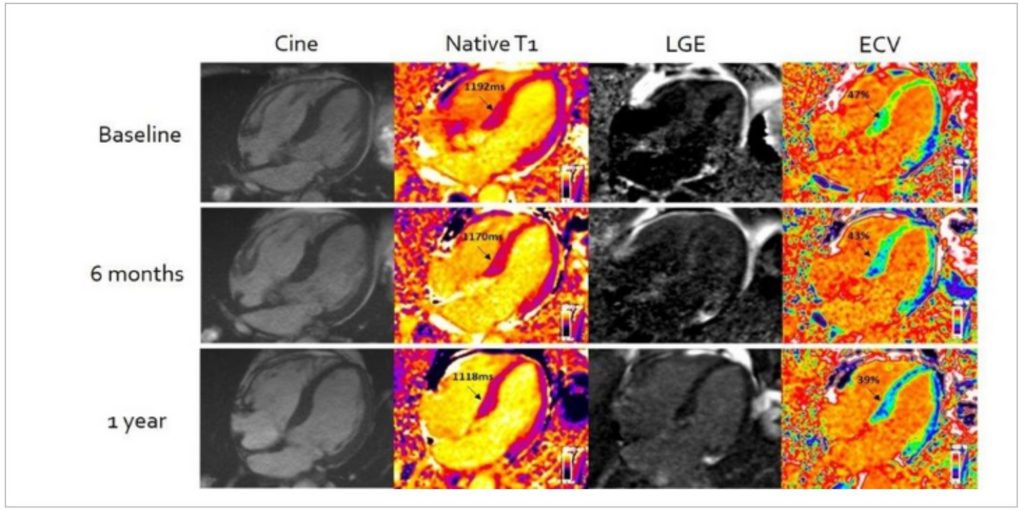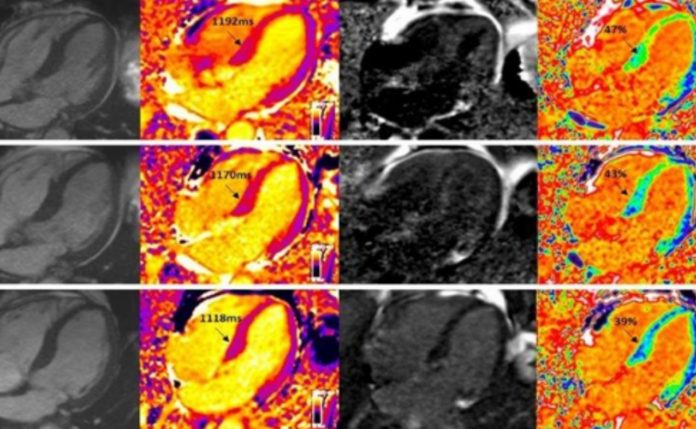Researchers at UCL and the Royal Free Hospital have created a sophisticated kind of cardiac MRI that allows doctors to assess the efficacy of treatment in patients with the deadly condition of stiff heart syndrome also known as Cardiac amyloidosis.
The breakthrough, which was reported in the European Heart Journal, allows clinicians to better direct treatment plans, which in turn improves patient prognosis, according to researchers.
When amyloid protein plaques accumulate in the heart muscle, they impair the heart’s ability to pump blood. This condition is known as stiff heart syndrome and, if left untreated, can quickly result in heart failure and death.
However, diagnosing the illness has proven challenging because there is no reliable test to determine the amount of amyloid in the heart, even if clinicians can detect its presence.
This also meant that chemotherapy—the standard first-line treatment—could not be evaluated therapeutically.
Currently, clinicians employ indirect biological markers to evaluate a patient’s response, but these don’t measure the quantity (or reduction) of cardiac amyloid, the drug’s primary target, and specialists find the indicators less helpful when evaluating second-line chemotherapy therapies.
To address this, UCL researchers at the National Amyloidosis Centre have been developing and perfecting Cardiovascular Magnetic Resonance (CMR) Extracellular Volume Mapping (ECV) for amyloid for the past ten years. Clinicians can use MRI to measure the quantity and presence of amyloid protein using this non-invasive method.
They are now using the technique for the first time to determine if cardiac amyloid is progressing or regressing in order to assess the efficacy of chemotherapy treatment.
For the study, Cardiovascular Magnetic Resonance with Extracellular Volume Mapping was performed on 176 individuals with light-chain cardiac amyloidosis. CMR scans with ECV mapping were performed at diagnosis and subsequently six, twelve, and twenty-four months after chemotherapy initiation.
The improved MRI technology enabled researchers to accurately detect the amount of amyloid protein in hearts as well as, for the first time, measure changes in response to chemotherapy on repeat images. By measuring the changes, it was possible to determine which individuals would have a favorable or unfavorable prognosis.
Additionally, when the findings were combined with blood tests for the condition, it was discovered that approximately 40% of patients showed a significant improvement (reduction) in amyloid deposition, something that was not previously thought to be possible – demonstrating the power of chemotherapy.

“In this study, we were assessing the ability and value of CMR to carry out ECV mapping,” explains Dr. Ana Martinez-Naharro, the study’s first author from the Division of Medicine at University College London (UCL), “to measure directly the changes in amyloid proteins in the heart in response to chemotherapy and how they correlate with the indirect markers that currently exist.
“The scans and data made available using this technique,” the researcher adds, “gave us the information to both see the amount of amyloid protein and also the regression in amyloid during the course of chemotherapy treatment.
“This is incredibly valuable for clinicians; knowing the amount, rather than just the presence of amyloid means they can better guide treatment option, by more accurately deciding timing and protocol of second line chemotherapy treatments.”
There are between 4,000 and 5,000 amyloidosis sufferers in the US, although many more go undiagnosed. Men than women are more likely to have the illness.
The study’s senior author, Professor Marianna Fontana (UCL Division of Medicine), a British Heart Foundation (BHF) Clinical Fellow, recommended that all cases with light-chain cardiac amyloidosis be diagnosed and evaluated right away using this UCL-developed MRI approach.
“Since MRI scans are widely available, by developing the use of ECV mapping in a machine that already is used for these patients, we hope that its use can be made available to more patients to help improve their care.
“The aim would be to use these scans routinely for all patients with the disease to help doctors monitor the response to chemotherapy to help improve patient survival, which is very poor in patients who do not respond to treatment.”
Patients were recruited and treated for the single-center trial at the National Amyloidosis Centre, which is part of the UCL Division of Medicine and situated at the Royal Free Hospital in London.
“Twenty years ago, another MRI technique called T2*,” adds Professor Fontana says, “was proven to be able to do the same thing for measuring the amount of iron in the heart in a condition called thalassemia.”
It has been used for the past 20 years to track patients’ responses to treatment and enable clinicians to make adjustments as needed. As a result, thalassemia patients are now living longer.
“As T2* has changed the landscape for this condition, tracking changes using ECV mapping of the heart may completely change the landscape for patients with amyloidosis, with the potential of guide treatment and, in the process, lead to improvements in patient outcomes.”
Source: 10.1093/eurheartj/ehac363
Image Credit: UCL
You were reading: Breakthrough Offers a New Diagnosis for Patients With “Stiff Heart Syndrome”
